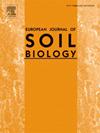Changes in carbon and nitrogen stable isotopic ratios with decomposition of plant residue
IF 3.3
2区 农林科学
Q1 ECOLOGY
引用次数: 0
Abstract
The transformation of plant residue into soil organic matter (SOM) plays a crucial role in maintaining the function of ecosystems. To elucidate the formation processes of SOM from plant residue, we examined changes in carbon (C) and nitrogen (N) contents, along with δ13C and δ15N values, during the decomposition of Artemisia princeps residue in an incubation experiment using 100 % quartz sand as an artificial soil. The results indicated that plant residue decomposition occurred in two distinct stages: (1) a rapid initial loss of C and N (43–54 % and 36–47 %, respectively) within the early 90 days, followed by (2) a slower loss (4–14 % and 7–15 %, respectively) over the remaining 90–360 days. In the early stage, δ13C and δ15N values increased similarly to trophic fractionation, with a δ15N/δ13C ratio of 1.54. In the latter stage, this ratio increased significantly to 12.8, probably due to increased C resistance to decomposition, while continuous N metabolism. By integrating data from both the literature and our study, we concluded that C and N in plant residue undergo one to two times the metabolic turnover relative to trophic turnover to form stable SOM. These findings are essential for understanding the preservation of plant residue, particularly labile compounds, in soils. This preservation would occur through microbial transformation. Our study offers a theoretical framework for understanding the SOM dynamics based on δ13C and δ15N values, emphasizing the utility of stable C and N isotope analyses in elucidating SOM transformation.

植物残体分解过程中碳氮稳定同位素比值的变化
植物残茬向土壤有机质的转化对维持生态系统的功能起着至关重要的作用。为了阐明植物残渣中SOM的形成过程,我们采用100%石英砂作为人工土壤,研究了青蒿残渣分解过程中碳(C)和氮(N)含量以及δ13C和δ15N值的变化。结果表明,植物残体分解分两个阶段:(1)初90 d内C和N的快速损失(分别为43 - 54%和36 - 47%),随后(2)90 - 360 d内C和N的缓慢损失(分别为4 - 14%和7 - 15%)。早期δ13C和δ15N值的增加与营养分馏相似,δ15N/δ13C比值为1.54。在后期,这一比例显著增加到12.8,可能是由于C对分解的抵抗力增强,同时N的代谢持续进行。通过综合文献数据和我们的研究,我们得出结论,植物残体中的C和N相对于营养周转要经历一到两倍的代谢周转才能形成稳定的SOM。这些发现对于了解植物残留物,特别是不稳定化合物在土壤中的保存是至关重要的。这种保存将通过微生物转化来实现。我们的研究为理解基于δ13C和δ15N值的SOM动力学提供了理论框架,强调了稳定C和N同位素分析在阐明SOM转变中的作用。
本文章由计算机程序翻译,如有差异,请以英文原文为准。
求助全文
约1分钟内获得全文
求助全文
来源期刊

European Journal of Soil Biology
环境科学-生态学
CiteScore
6.90
自引率
0.00%
发文量
51
审稿时长
27 days
期刊介绍:
The European Journal of Soil Biology covers all aspects of soil biology which deal with microbial and faunal ecology and activity in soils, as well as natural ecosystems or biomes connected to ecological interests: biodiversity, biological conservation, adaptation, impact of global changes on soil biodiversity and ecosystem functioning and effects and fate of pollutants as influenced by soil organisms. Different levels in ecosystem structure are taken into account: individuals, populations, communities and ecosystems themselves. At each level, different disciplinary approaches are welcomed: molecular biology, genetics, ecophysiology, ecology, biogeography and landscape ecology.
 求助内容:
求助内容: 应助结果提醒方式:
应助结果提醒方式:


